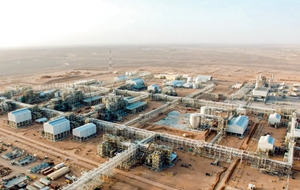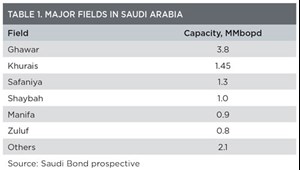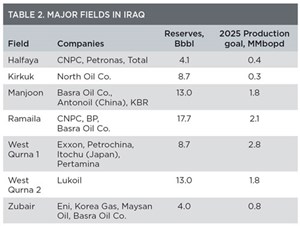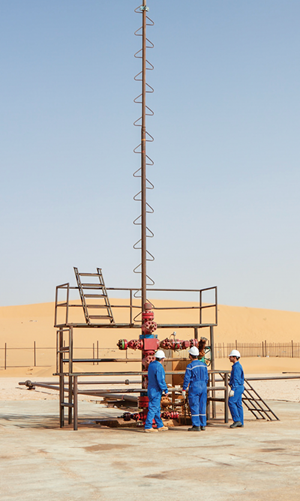Regional report: MENA
Activity in this region, stretching from western Asia to northwestern Africa, remains at a fairly high level. Indeed, our mid-year forecast in last month’s issue shows that the Middle Eastern region’s drilling should be up 6.5% this year. Likewise, the four main countries making up North African activity—Algeria, Egypt, Libya and Tunisia—are predicted to see their drilling rise 9.3%.
Similarly, Middle Eastern oil production has remained level over the last year, held back from an increase mostly by a 4.9% reduction in Iranian output. And North African output rose 3.8% last year, to more than 2.95 MMbopd. Much of the increases in both drilling and production can be traced to two things: 1) a renewed focus on reserve replacement by some countries; and 2) a deliberate plan by other countries to increase productive capacity beyond routine reserve replacement.
MIDDLE EAST
Saudi Arabia has long been an OPEC leader and swing producer in controlling world oil supply and stabilizing crude prices, holding 226 Bbbl of oil reserves and stated production capacity of 12 MMbopd.
At this writing, 5.7 MMbpd of Saudi Aramco’s oil output were taken off-line, because of drone and missile attacks on the Abqaiq processing facility and the Khurais oil field. Huthi rebels claimed to have launched the attacks from Yemen. The attacks set off fires that caused significant damage. However, Aramco officials said that Khurais would be back online completely by the end of September. They said that the country’s full productive capacity would be restored by November.
Meanwhile, Crown Prince Mohammed Bin Salman’s Vision 2030 plan to diversify the Saudi economy calls for private investment in Aramco through a bond offering and an IPO to sell 5% of the company. In rare financial disclosures related to the bond offering, Saudi Aramco reported $111.1 billion in after-tax profits for 2018 and estimated its total market value to be $2 trillion. Replacement of the Saudi energy minister with an investment banker, who heads the kingdom’s sovereign wealth fund, as chairman of Aramco likely indicates that the IPO, three years in the making, will take place soon.
In July 2019, Saudi Aramco produced 9.8 MMbopd, with spare capacity of 2.2 MMbopd. Aramco’s major oilfields and their estimated daily production are listed in Table 1. Before the September attack, Saudi Aramco had pledged to export only 7 MMbopd to help stabilize oil markets, with the remaining 2.8 MMbopd to be used domestically.
The Vision 2030 roadmap also calls for generating 70% of the kingdom’s power using natural gas. To produce natural gas for power generation and desalinization, Aramco is aggressively developing the kingdom’s shale gas resources. According to Aramco President and CEO Amin Nasser, the company has 16 active rigs drilling for shale gas as part of a $150-billion program to increase gas production to 23 Bcfd from the current 14 Bcfd over the next decade.
Saudi Aramco is investing heavily to continue development in its 101 conventional oil fields to maintain its 12-MMbpd capacity. Legendary Ghawar field (recently surpassed as the world’s largest by the Permian basin) has declined, now producing 3.8 MMbopd, compared to its 5-MMbopd peak. The coastal Manifa field development has achieved target production of 900,000 bopd.
In addition, Aramco is expanding several mature offshore fields. The Safaniya Phase 7 redevelopment will receive $600 million to $700 million. The Zuluf field expansion should add 600,000 bpd of heavy crude production by 2023. Aramco also announced an $18-billion commitment for 34 contracts for engineering, 35 production platforms, and subsea pipelines in Marjan and Berri fields to increase production by 550,000 bopd and 2.5 Bcfd. Berri also will have nine new onshore drilling sites.
Baker Hughes Company reports that 77 onshore rigs were working in the kingdom during July 2019. With encouragement from the Saudi government, local companies have increased their ownership of rigs working in the kingdom and throughout the Middle East region.
Iraq. With 149 Bbbl of reserves, Iraq has recovered from its years of conflict , and now produces 4.88 MMbopd, up from 1.3 MMbopd in 2003. Oil contributes more than 90% of the country’s public revenues. The rejuvenation of Iraq’s production capacity has been made possible through participation by international oil companies (IOCs), which have brought financial and technical assistance.
Current production is close to the maximum 5.0 MMbopd attainable with existing facilities. Seven major fields among Iraq’s 30 oil fields hold half of the country’s reserves and contribute most of its production, Table 2. Aside from Kirkuk, all major fields are in the southern and central regions, sending crude to Basra export facilities for tanker transport.
IOCs have participated in Iraq’s oil industry since 2009 through technical service contracts (TSCs) and production sharing contracts (PSCs), which pay a small fee (up to $2.00) for every barrel of incremental production. IOCs generally hold 75% interest in the fields, with the Iraqi national oil companies—Basra Oil Co., North Oil Co., and Midland Oil Co.—holding 25%.
ExxonMobil holds a TSC for West Qurna I field, plus six PSCs covering 848,000 acres in Iraqi Kurdistan. After operating in Iraq from the 1920s to the 1970s, BP returned to the country in 2009 with a TSC to increase production from giant Ramaila field. BP also provides technical assistance to North Oil Co. in Kirkuk field.
Russia’s Lukoil holds the TSC for West Qurna II, and Eni and Korea Gas provide resources and expertise for Zubair field. CNPC’s Petrochina has TSCs for Ahdab, Ramaila, and Halfaya I, II and III fields, and also has equity in West Qurna I. Chinese companies invested more than $2 billion in Iraq and are purchasing 1.5 MMbpd of Iraqi crude.
The Kurdistan regional government has managed fields in Iraq’s north that produce less than 10% of the country’s output. Oil produced there is sent by pipeline to the Turkish port of Ceyhan. After 93% of Kurds voted for independence in 2017, the Iraqi army advanced on the region and seized control of several oil fields, including Kirkuk.
Iraq has 132 Tcf of natural gas reserves, but for lack of pipelines, the country is flaring 1.7 Bcfd from its 30 fields. The Iraqi oil ministry has tasked state-run Midland Oil Co. to develop the 4.5-Tcf Mansuriya field. The ministry is working with IOCs to help reach a production goal of 300 MMcfd. Another big initiative to increase production capacity is the South Iraq Integrated Project. The proposed $53-billion project is designed to transport 12.5 MMbpd of seawater for injection to increase reservoir pressure in six fields.
United Arab Emirates. Ninety-six percent of the UAE’s 98.63 Bbbl of oil reserves are in Abu Dhabi and controlled by Abu Dhabi National Oil Company (ADNOC). ADNOC is pursuing its Smart Growth 2030 strategy, to increase production from the current 3.0 MMbopd to 4.0 MMbopd in 2020, and 5.0 MMbopd by 2030. The strategy also calls for Abu Dhabi to become self-sufficient in natural gas, and an LNG exporter. In November 2018, Abu Dhabi’s Supreme Petroleum Council approved a $132-billion, five-year capital plan.
Chinese companies have invested prominently in ADNOC. Since 2017, CNPC has held 40-year stakes in ADNOC’s onshore and offshore concessions. In July 2018, ADNOC and CNPC signed a “strategic cooperation framework agreement,” covering additional opportunities upstream, midstream and downstream. In March 2019, CNPC paid $1.2 billion for a 10% interest in the Lower Zakum, Umm Sharif, Nasir and Al Yasat concessions. China Petroleum Engineering Construction Corporation has an EPC contract to expand production from Bab field onshore.
Eni will contribute 25% of the development costs to develop ultra-sour gas in Ghasha, Hail and Dalma fileds. The objective is to produce 1.5 Bcfd by 2025, along with 120,000 bpd of oil and condensate. KBR and Artelia have been contracted to build artificial islands for this development. FEED contracts for infrastructure have been awarded to Bechtel and TechnipFMC.
Eni and Thailand’s PTTEP acquired stakes in one onshore and two offshore fields in Abu Dhabi’s first licensing round in 2018. Eni has small stakes in several other concessions. Indian companies Bharat Petroleum and Indian Oil Co. Ltd. also won an onshore block. Occidental agreed in February 2019 to explore onshore Block 3.
To develop unconventional gas in the Ruwais Diyab concession, ADNOC awarded a 40-year, 40% stake to Total, to target 1.0-Bcfd production by 2030. ADNOC signed an EPC contract with Tecnicas Reunidas for a $1.4-billion upgrade of Bu Hasa field, which has been producing since 1965.
Iran. The Iranian Republic has yet to recover oil production levels achieved before 1979, and the current international situation has put the country’s energy sector under considerable stress. Half of the country’s production comes from fields that are more than 50 years old, and significant investment is needed. Facing U.S. sanctions, National Iranian Oil Company (NIOC) has worked to develop the domestic oilfield equipment and supply industry; stored unsold crude oil both on- and offshore; and has sought foreign investment.
NIOC and the National Iranian Drilling Company reportedly have signed deals with 88 domestic manufacturers to produce equipment, including downhole tools, pumps, drill bits, and valves. More than 230 Iranian companies are seeking additional business with the two national firms.
Given the sanctions, Iran has sought investment and export markets in China, Russia and Turkey. China has continued to purchase up to 925,000 bopd from Iran through “gray market” sales. Significantly, China confirmed a 25-year agreement with Iran in August 2019, to invest $280 billion to develop Iran’s oil, gas and petrochemical sectors, and another $120 billion in pipelines and manufacturing infrastructure.
After Total pulled out of the South Pars 11 development, due to sanctions, CNPC increased its stake in the field to 80%. CNPC and Sinopec are operating the West Karoun oil fields, with a plan to increase production 500,000 bopd by the end of 2020.
Kuwait has produced oil for more than 80 years, and investment in upgrades and increased output are past due. In 2018, the oil ministry outlined a $500-billion plan to increase production to 4.75 MMbopd and improve infrastructure, but the strategy has been implemented slowly. As of June 2019, $62 billion of projects were underway in the country.
Giant Burgan field, discovered in 1938, has been in decline but it still produces 1.7 MMbopd of the country’s 3.25-MMbopd capacity. In 2017, Kuwait Petroleum Company (KPC) signed a technical service agreement with BP to extend field life. In addition, Petrofac has been contracted to install a 120,000-bopd gathering station, to start up in 2020.
Kuwait Oil Company (KOC) has awarded contracts for 86 drilling rigs, 47 of which are operating. KOC also has awarded Halliburton a $597-million contract to drill six HPHT offshore wells from two rigs. In addition, Kuwait has invested in heavy oil fields in its north, to increase heavy oil production from 60,000 bopd to 430,000 bopd by 2040.
Production in the Neutral Zone with Saudi Arabia has been shut-in since a 2015 dispute over Chevron’s operatorship of Khafji field. Bloomberg reported that the two countries are close to an agreement that would make 500,000 bopd available to the market.
Qatar is the world’s largest LNG exporter but produces only around 600,000 bopd. Last December, Qatar withdrew from OPEC, effective Jan. 1, 2019, to concentrate on its natural gas business. With 900 Tcf of recoverable reserves, Qatar’s North Field in the Persian Gulf is the world’s largest unassociated natural gas field. In 2005, Qatar Petroleum (QP) ceased further development of the field, to study its long-term sustainability. In April 2017, Qatar lifted the moratorium, announcing that it would increase LNG production 43%, from 77 million metric tons/year to 110 million metric tons/year by 2024, mostly through the North Field Expansion Project.
In April 2019, QP signed contracts for 80 new wells from eight platforms in the North Field Expansion. In addition, McDermott was awarded a $750-million EPCI contract for North Field sustainability, and a FEED contract for offshore wellhead platforms, pipelines and cables. QP has shortlisted IOCs, such as Total, ExxonMobil and Eni, to be partners in the North Field Expansion, although Qatar says that it can complete the project on its own.
Oman. According to the U.S. EIA, Oman during 2017 participated in production cuts agreed to by OPEC members. Because of this agreement, oil production fell from peak 2016 levels, averaging 974,600 bpd in 2017 and 978,550 bpd in 2018.

In July 2019, Petroleum Development Oman’s (PDO) Rabab Harweel Integrated Project (RHIP, Fig. 1) entered the start-up phase with gas production from the first sour wells, marking a key milestone for the mega project and coming two months ahead of schedule.
This is a significant step in the commissioning process, and work is progressing to initiate and stabilise the hydrocarbon processing facilities and to line up more wells. The plant’s capacity continues to be ramped up.
RHIP is an integrated oil and gas development across the Rabab and Harweel reservoirs in southern Oman. It is the largest capital project in PDO’s history, representing a reserve addition of more than 500 MMboe.
NORTH AFRICA
Algeria still relies on hydrocarbon revenues for about one-third of total government funds. To attract additional foreign investment, the government has been drafting a new hydrocarbons law, which would make Algeria more competitive by reducing taxes, simplifying licensing and shortening the time to craft agreements. Currently, state firm Sonatrach owns about 80% of hydrocarbon production in Algeria, while IOCs account for the remaining 20%.
Despite sharply lower oil prices since July 2014, Sonatrach said that it will maintain investment of $18 billion to $23 billion annually. With most of Algeria’s hydrocarbon output derived from mature, depleting fields (Fig. 2), but with a need to boost production, an emphasis is being placed on enhanced recovery technology. Accordingly, Sonatrach is working to form partnerships with foreign investors to transfer technology quicker.
Algerian oil reserves (crude and condensate) totaled an estimated 14.55 Bbbl at the end of 2018, and proved gas reserves are about 159.1 Tcf. Algeria produced an estimated 1.024 MMbpd of crude oil last year, plus another 280,000 bpd of lease condensate. During 2017, the U.S. EIA estimates (based on vessel tracking data) that Algeria exported roughly 580,000 bpd of crude and condensate.
Also, according to EIA, Algeria’s gross natural gas production is running between 6.5 Tcf and 7.0 Tcf/year. Considerable amounts of gas are either reinjected into wells to enhance oil recovery or are vented/flared. The remainder is either used for domestic consumption or exported to other countries.
During the last two years, Algeria has been completing the first phase of its Southwest Gas Project. The first phase includes Reggane Nord and Timimoun fields, which began production in December 2017 and February 2018, respectively, along with Touat, which finally began exports on Sept. 9, 2019.
London-based Neptune Energy Group and Sonatrach began natural gas production during first-half 2019 as part of the commissioning of the partnership’s Touat project in the Sbaa basin, 930 mi southwest of Algiers, near Adrar. The development will produce about 450 MMcfd of gas at plateau. Touat comprises eight gas fields and a gas processing plant. Project development involved drilling 18 development wells, along with gathering and treatment and other facilities.
Algeria possesses 707 Tcf of technically recoverable shale gas. Sonatrach reportedly has signed several cooperation agreements with IOCs to develop unconventional resources. According to Sonatrach, about two-thirds of Algerian territory remains unexplored or largely underexplored. Sonatrach is also pursuing offshore exploration, focused on two large geographical areas that look promising, based on seismic data.
In March 2019, Petrofac was awarded a $1-billion, 42-month contract by the joint operating group set up by Sonatrach, Petroceltic and Enel, for the Ain Tsila gas development. The EPC project scope includes commissioning, start-up and performance testing.
- Due to the government’s encouragement, numerous IOCs operate in the country. Egypt’s upstream industry is managed by the Ministry of Petroleum and Mineral Resources, under which five state owned companies operate, including the Egyptian General Petroleum Corporation (EGPC). EGPC handles production sharing agreements (PSAs) with the IOCs.
Since the 1990s, Egyptian officials have enacted various laws designed to attract additional operators and investments. Between November 2013 and December 2017, Egypt’s oil sector signed 83 exploration and development deals with IOCs worth at least $15.5 billion, plus signing bonuses of more than $1 billion for the drilling of 319 wells. In 2018, a new international bidding round was announced, including blocks in the Gulf of Suez, Western Desert, Nile Delta and offshore Mediterranean. In 2019, the ministry awarded contracts for 12 new concessions featuring ExxonMobil, Shell, BP and other operators. Estimated initial investment is around $800 million.
The Egyptian government just closed a 2019 bidding round in August for 10 offshore tracts in the Red Sea. Winning bids should be announced in the next several months.
Government investment in natural gas projects increased 25% during FY 2017. This is in addition to a 33% boost during the previous fiscal year. In addition, several multinational firms announced commitments to increase their crude oil investments to a total of $10 billion during FY 2018-2019. Accordingly, Egyptian drilling should be up 6% this year.
Zohr field, the largest Egyptian and Mediterranean gas discovery ever made, sits within the offshore Shorouk Block. In December 2017, operator Eni started output from Zohr. By August 2019, Eni said Zohr production had reached more than 2.7 Bcfd, five months ahead of the Plan of Development (PoD). The start-up on Aug. 18, 2019, of the second 216-km, 30-in. pipeline, connecting subsea production facilities to an onshore treatment plant, paves the way to increase the field’s production rate up to 3.2 Bcfd. Egypt’s oil production was up about 1% in 2018, at 619,750 bpd. At the end of 2018, proven reserves stood at 3.1 Bbbl of oil and 77.5 Tcf of gas.
Libya’s upstream sector has improved this year, although it is still somewhat precarious. Back in May, the country’s National Oil Corporation (NOC) reported monthly income of $2.3 billion from crude oil and product sales, along with taxes and royalties received from concession contracts. This represented a 24% monthly increase amounting to $448 million. Revenue figures were bolstered by stable global oil prices, as well as a steady crude loading schedule.
“These figures showcase the importance of a unified oil sector and its contribution to the economy,” said NOC Chairman Mustafa Sanalla during an industry conference at the time, quoted by Oil and Gas Middle East. “Our focus on crude production, despite ongoing security challenges, continues to bring success, with over $725 million having been spent on exploration and drilling since 2018.”
At that point, oil markets were generally ignoring Libya’s ongoing civil war. However, on July 20, NOC reported that production at its El Sharara oil field had ceased. As a direct result, NOC also stopped the shipment of crude oil at the Port of Az Zawiyah, resulting in a production loss of 290,000 bopd and a force-majeure declaration that was lifted on July 22.
Officials indicated that an unidentified group shut a valve on the pipeline linking El Sharara to Zawiya, 30 mi west of Tripoli. The force-majeure brought official NOC output below 1 MMbopd, from a level of up to 1.3 MMbopd.
Meanwhile, back in May, Sanalla held meetings with U.S. companies at the Offshore Technology Conference (OTC) in Houston, to recruit $60 billion of procurement contracts necessary to more than double Libyan oil production by 2023. This is part of Libya’s plan to expand production from about 1.0 MMbopd now to 2.1 MMbopd by 2023.
- Oil production was up 5.2% in 2018, at 40,700 bpd. Oil reserves were down 1.0%, while gas reserves remained even. Drilling is predicted to rise 33%, to 16 wells, with a small pickup in exploration. In August 2019, Panoro Energy said that it expected to spud the SMW-1 well this December on the Salloum West oil prospect, on the Sfax offshore exploration permit.
Tunisia was set to almost double its natural gas production, to about 65,000 boed, once the southern Nawara gas field goes onstream. The project is jointly owned by OMV and ETAP, with investments of about $700 million.
The Nawara concession is derived from the Jenein Sud exploration permit. The project will deliver gas and by-products to the Tunisian market. Field facilities will pre-treat raw gas and recover condensate. A 24-in. pipeline will carry gas from the Nawara concession to a gas treatment plant in Gabès. As of mid-summer 2019, work on the project was still finishing.

- Coiled tubing drilling’s role in the energy transition (March 2024)
- The reserves replacement dilemma: Can intelligent digital technologies fill the supply gap? (March 2024)
- Oil and gas in the Capitals (February 2024)
- What's new in production (February 2024)
- Digital tool kit enhances real-time decision-making to improve drilling efficiency and performance (February 2024)
- E&P outside the U.S. maintains a disciplined pace (February 2024)





